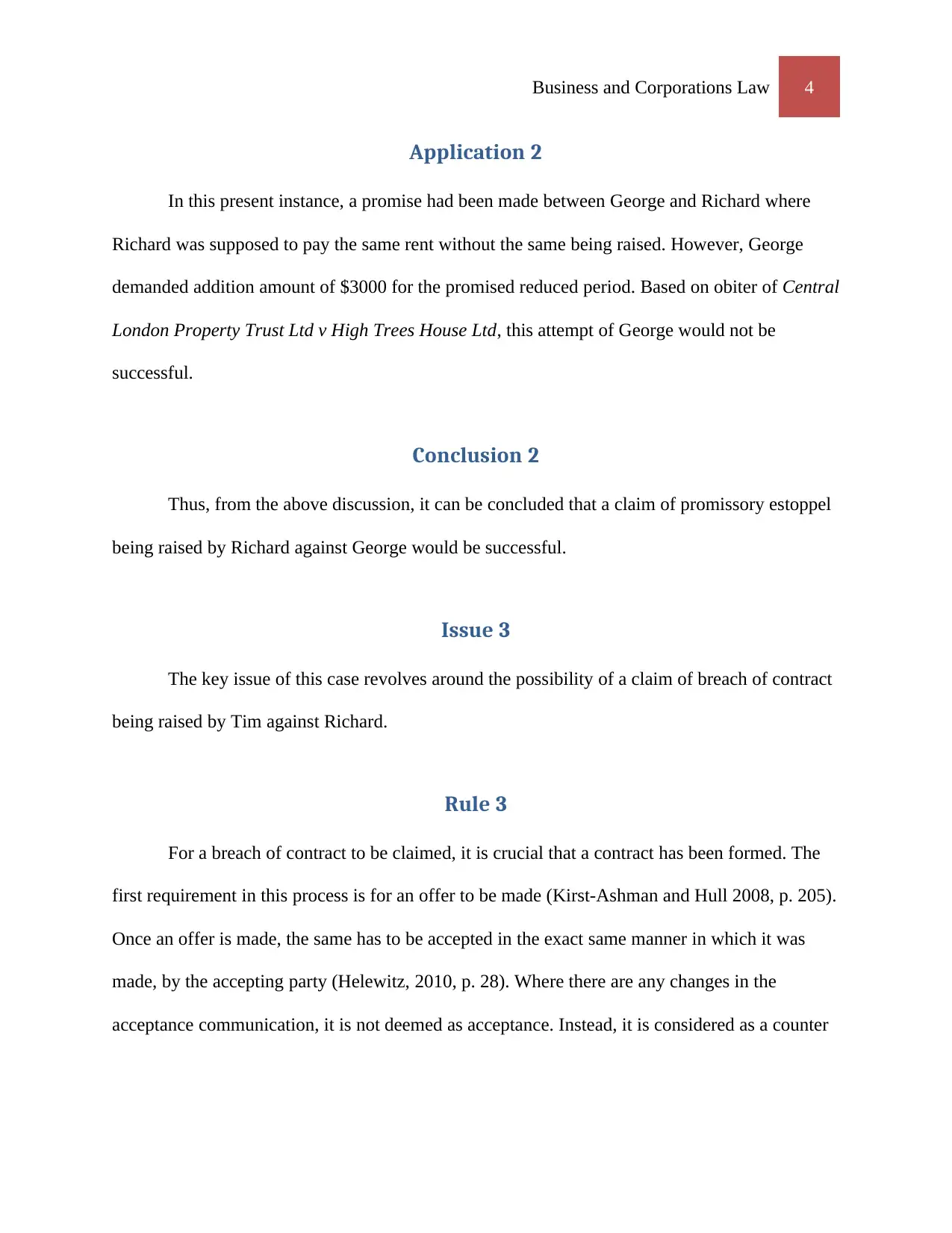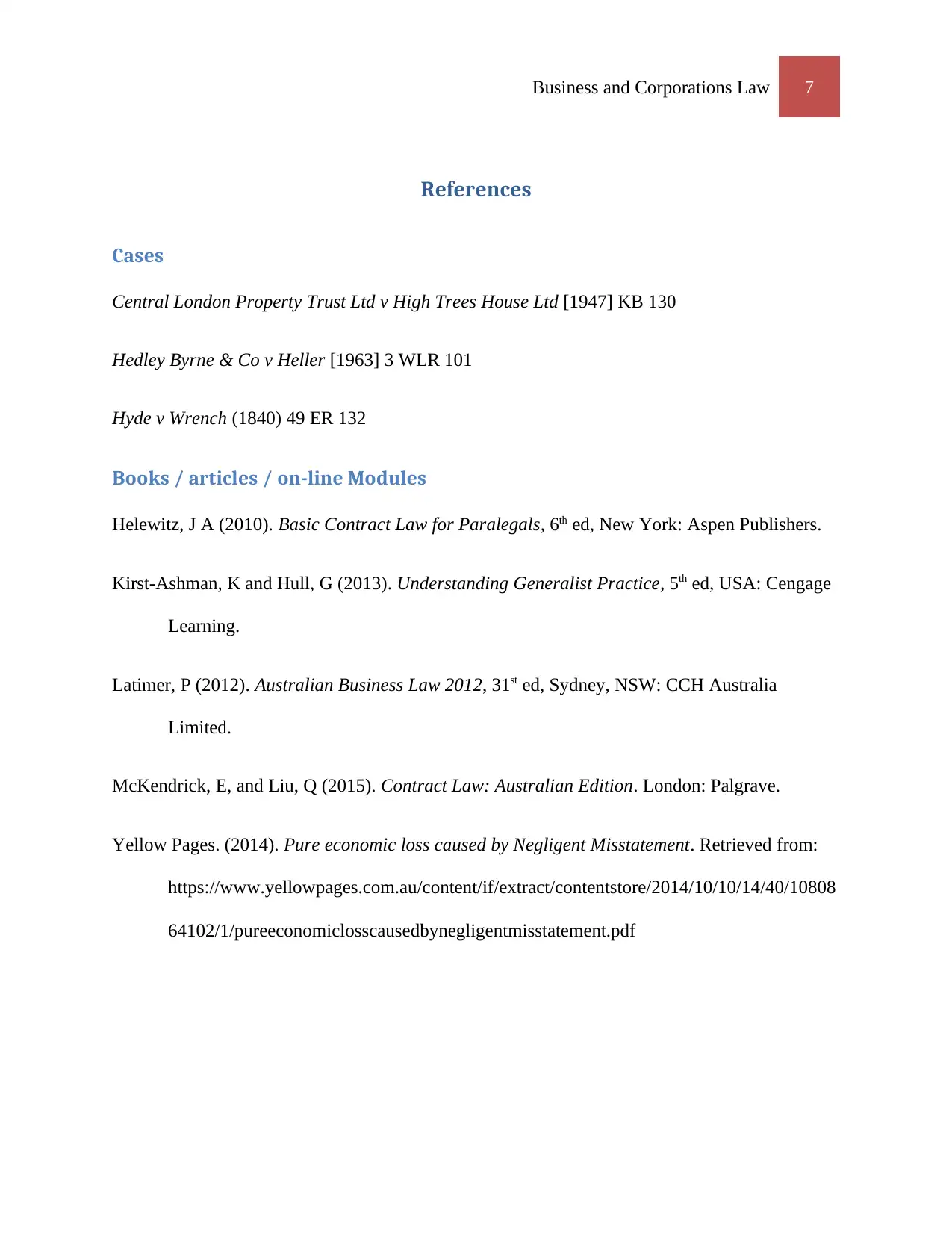Business and Corporations Law: Case Study Analysis - 2018
VerifiedAdded on 2021/04/17
|7
|1337
|35
Case Study
AI Summary
This case study analyzes four key legal issues arising from a business scenario. The first issue examines a potential claim of negligent misstatement, applying the principles established in Hedley Byrne & Co v Heller to determine liability. The second issue explores a claim of promissory estoppel, referencing Central London Property Trust Ltd v High Trees House Ltd to assess whether a promise can be enforced despite a lack of consideration. The third and fourth issues address potential breaches of contract, focusing on contract formation, the concept of a counter offer (Hyde v Wrench), and the requirement of valid consideration. The analysis concludes that a claim of negligent misstatement and promissory estoppel would likely succeed, while claims of breach of contract would fail due to the absence of a valid contract formation.

Paraphrase This Document
Need a fresh take? Get an instant paraphrase of this document with our AI Paraphraser

Business and Corporations Law 2
Issue 1
The key issue of this case revolves around the possibility of a claim of negligent
misstatement being raised against Emma by Richard.
Rule 1
Misrepresentation shows the false statement of law or fact being made, so as to induce
the other side of the contracting party, to go forward with the contract. There are three types of
misrepresentation, one of which is negligent misrepresentation. This is also referred to as
negligent misstatement. It refers to the advice or information which is given in an honest manner
but which is actually misleading or inaccurate. In such cases, damages can be claimed by the
aggrieved party (Yellow Pages, 2014).
In order to make a claim of negligent misstatement, Hedley Byrne & Co v Heller [1963] 3
WLR 101 provides the fulfilment of four points. Firstly, there has to be relationship of trust and
confidence between the parties; followed by the individual giving information assuming
voluntary risk; next comes the other party placing reliance over the provided information; and
lastly, this reliance was reasonable based on conditions present.
Application 1
In the present instance, Emma negligent looked at the wrong page on the brochure while
providing the information to Richard. There is a need to fulfil the four requirements placed
through Hedley Byrne & Co v Heller here. There was a relation of trust and confidence between
Issue 1
The key issue of this case revolves around the possibility of a claim of negligent
misstatement being raised against Emma by Richard.
Rule 1
Misrepresentation shows the false statement of law or fact being made, so as to induce
the other side of the contracting party, to go forward with the contract. There are three types of
misrepresentation, one of which is negligent misrepresentation. This is also referred to as
negligent misstatement. It refers to the advice or information which is given in an honest manner
but which is actually misleading or inaccurate. In such cases, damages can be claimed by the
aggrieved party (Yellow Pages, 2014).
In order to make a claim of negligent misstatement, Hedley Byrne & Co v Heller [1963] 3
WLR 101 provides the fulfilment of four points. Firstly, there has to be relationship of trust and
confidence between the parties; followed by the individual giving information assuming
voluntary risk; next comes the other party placing reliance over the provided information; and
lastly, this reliance was reasonable based on conditions present.
Application 1
In the present instance, Emma negligent looked at the wrong page on the brochure while
providing the information to Richard. There is a need to fulfil the four requirements placed
through Hedley Byrne & Co v Heller here. There was a relation of trust and confidence between

Business and Corporations Law 3
Emma and Richard as Richard contacted shock-absorber Company which was supposed to have
the correct information. By giving the information, Emma voluntarily assumed the risk. And
reasonably, Richard had placed reliance on Emma’s information due to the position held by her.
The four requirements are thus fulfilled.
Conclusion 1
Thus, from the above discussion, it can be concluded that a claim of negligent
misstatement can be raised against Emma by Richard. This would allow Richard to claim $ 2000
damage from Emma.
Issue 2
The key issue of this case revolves around the possibility of a claim of promissory
estoppel being raised by Richard against George.
Rule 2
Promissory estoppel is a leading concept under the contract law which stops an individual
from going back on the promise which has been made, where the other party relied on this
promise (Latimer, 2012, p. 352). The obiter statement given under Central London Property
Trust Ltd v High Trees House Ltd [1947] KB 130 is of particular significance here. In this case,
Denning J provided that the person who places reliance on promise of reduced compensation,
cannot be allowed to go back on such promise, even when it is not supported by consideration.
Emma and Richard as Richard contacted shock-absorber Company which was supposed to have
the correct information. By giving the information, Emma voluntarily assumed the risk. And
reasonably, Richard had placed reliance on Emma’s information due to the position held by her.
The four requirements are thus fulfilled.
Conclusion 1
Thus, from the above discussion, it can be concluded that a claim of negligent
misstatement can be raised against Emma by Richard. This would allow Richard to claim $ 2000
damage from Emma.
Issue 2
The key issue of this case revolves around the possibility of a claim of promissory
estoppel being raised by Richard against George.
Rule 2
Promissory estoppel is a leading concept under the contract law which stops an individual
from going back on the promise which has been made, where the other party relied on this
promise (Latimer, 2012, p. 352). The obiter statement given under Central London Property
Trust Ltd v High Trees House Ltd [1947] KB 130 is of particular significance here. In this case,
Denning J provided that the person who places reliance on promise of reduced compensation,
cannot be allowed to go back on such promise, even when it is not supported by consideration.
⊘ This is a preview!⊘
Do you want full access?
Subscribe today to unlock all pages.

Trusted by 1+ million students worldwide

Business and Corporations Law 4
Application 2
In this present instance, a promise had been made between George and Richard where
Richard was supposed to pay the same rent without the same being raised. However, George
demanded addition amount of $3000 for the promised reduced period. Based on obiter of Central
London Property Trust Ltd v High Trees House Ltd, this attempt of George would not be
successful.
Conclusion 2
Thus, from the above discussion, it can be concluded that a claim of promissory estoppel
being raised by Richard against George would be successful.
Issue 3
The key issue of this case revolves around the possibility of a claim of breach of contract
being raised by Tim against Richard.
Rule 3
For a breach of contract to be claimed, it is crucial that a contract has been formed. The
first requirement in this process is for an offer to be made (Kirst-Ashman and Hull 2008, p. 205).
Once an offer is made, the same has to be accepted in the exact same manner in which it was
made, by the accepting party (Helewitz, 2010, p. 28). Where there are any changes in the
acceptance communication, it is not deemed as acceptance. Instead, it is considered as a counter
Application 2
In this present instance, a promise had been made between George and Richard where
Richard was supposed to pay the same rent without the same being raised. However, George
demanded addition amount of $3000 for the promised reduced period. Based on obiter of Central
London Property Trust Ltd v High Trees House Ltd, this attempt of George would not be
successful.
Conclusion 2
Thus, from the above discussion, it can be concluded that a claim of promissory estoppel
being raised by Richard against George would be successful.
Issue 3
The key issue of this case revolves around the possibility of a claim of breach of contract
being raised by Tim against Richard.
Rule 3
For a breach of contract to be claimed, it is crucial that a contract has been formed. The
first requirement in this process is for an offer to be made (Kirst-Ashman and Hull 2008, p. 205).
Once an offer is made, the same has to be accepted in the exact same manner in which it was
made, by the accepting party (Helewitz, 2010, p. 28). Where there are any changes in the
acceptance communication, it is not deemed as acceptance. Instead, it is considered as a counter
Paraphrase This Document
Need a fresh take? Get an instant paraphrase of this document with our AI Paraphraser

Business and Corporations Law 5
offer as per Hyde v Wrench (1840) 49 ER 132. And a counter offer results in the end of original
offer.
Application 3
In the present instance, an offer had been made by Tom to Richard regarding buying a
particular car for a price of $18,500. However, on this offer, Richard sent his counter offer based
on Hyde v Wrench as he changed the consideration value to $19,000. This counter offer was
rejected by Tom. On this, Richard attempted to accept the original offer. However, the original
offer of $18,500 had expired with the counter offer of $19,000.
Conclusion 3
Thus, from the above discussion, it can be concluded that due to counter offer, the
original offer cannot be accepted. As a contract was not formed, a breach of contract cannot be
claimed here.
Issue 4
The key issue of this case revolves around the possibility of a claim of breach of contract
being raised by Martin against Richard.
Rule 4
As stated earlier, formation of contract requires presence of certain elements. One of
these elements is consideration. There are certain rules associated with consideration and one of
these is that the consideration has to be present and cannot be past. It means that for the promise
offer as per Hyde v Wrench (1840) 49 ER 132. And a counter offer results in the end of original
offer.
Application 3
In the present instance, an offer had been made by Tom to Richard regarding buying a
particular car for a price of $18,500. However, on this offer, Richard sent his counter offer based
on Hyde v Wrench as he changed the consideration value to $19,000. This counter offer was
rejected by Tom. On this, Richard attempted to accept the original offer. However, the original
offer of $18,500 had expired with the counter offer of $19,000.
Conclusion 3
Thus, from the above discussion, it can be concluded that due to counter offer, the
original offer cannot be accepted. As a contract was not formed, a breach of contract cannot be
claimed here.
Issue 4
The key issue of this case revolves around the possibility of a claim of breach of contract
being raised by Martin against Richard.
Rule 4
As stated earlier, formation of contract requires presence of certain elements. One of
these elements is consideration. There are certain rules associated with consideration and one of
these is that the consideration has to be present and cannot be past. It means that for the promise

Business and Corporations Law 6
being undertaken in the promise, the consideration has to be paid for that act and consideration
undertaken in the past cannot be referred to. A contract without consideration is not valid, and it
is crucial that the consideration has economic value (McKendrick and Liu, 2015, p. 113).
Application 4
In the present instance, Martin enquires about hiring one of Richard’s cars. Richard then
tells Martin that despite the standard rate, he could hire the car for no consideration. This would
not be valid in the eyes of law as without consideration, a contract is not valid. Moreover, here
reference is made to past consideration in terms of Martin having looked after the car of Richard
in August. Here, this past consideration also cannot be used as valid consideration as past
consideration is not a accepted in contract law.
Conclusion 4
Thus, from the above discussion, it can be concluded that a contract had been not formed
between Martin and Richard for the lack of valid consideration. As there was no contract, a
breach of contract cannot be successfully claimed by Martin against Richard.
being undertaken in the promise, the consideration has to be paid for that act and consideration
undertaken in the past cannot be referred to. A contract without consideration is not valid, and it
is crucial that the consideration has economic value (McKendrick and Liu, 2015, p. 113).
Application 4
In the present instance, Martin enquires about hiring one of Richard’s cars. Richard then
tells Martin that despite the standard rate, he could hire the car for no consideration. This would
not be valid in the eyes of law as without consideration, a contract is not valid. Moreover, here
reference is made to past consideration in terms of Martin having looked after the car of Richard
in August. Here, this past consideration also cannot be used as valid consideration as past
consideration is not a accepted in contract law.
Conclusion 4
Thus, from the above discussion, it can be concluded that a contract had been not formed
between Martin and Richard for the lack of valid consideration. As there was no contract, a
breach of contract cannot be successfully claimed by Martin against Richard.
⊘ This is a preview!⊘
Do you want full access?
Subscribe today to unlock all pages.

Trusted by 1+ million students worldwide

Business and Corporations Law 7
References
Cases
Central London Property Trust Ltd v High Trees House Ltd [1947] KB 130
Hedley Byrne & Co v Heller [1963] 3 WLR 101
Hyde v Wrench (1840) 49 ER 132
Books / articles / on-line Modules
Helewitz, J A (2010). Basic Contract Law for Paralegals, 6th ed, New York: Aspen Publishers.
Kirst-Ashman, K and Hull, G (2013). Understanding Generalist Practice, 5th ed, USA: Cengage
Learning.
Latimer, P (2012). Australian Business Law 2012, 31st ed, Sydney, NSW: CCH Australia
Limited.
McKendrick, E, and Liu, Q (2015). Contract Law: Australian Edition. London: Palgrave.
Yellow Pages. (2014). Pure economic loss caused by Negligent Misstatement. Retrieved from:
https://www.yellowpages.com.au/content/if/extract/contentstore/2014/10/10/14/40/10808
64102/1/pureeconomiclosscausedbynegligentmisstatement.pdf
References
Cases
Central London Property Trust Ltd v High Trees House Ltd [1947] KB 130
Hedley Byrne & Co v Heller [1963] 3 WLR 101
Hyde v Wrench (1840) 49 ER 132
Books / articles / on-line Modules
Helewitz, J A (2010). Basic Contract Law for Paralegals, 6th ed, New York: Aspen Publishers.
Kirst-Ashman, K and Hull, G (2013). Understanding Generalist Practice, 5th ed, USA: Cengage
Learning.
Latimer, P (2012). Australian Business Law 2012, 31st ed, Sydney, NSW: CCH Australia
Limited.
McKendrick, E, and Liu, Q (2015). Contract Law: Australian Edition. London: Palgrave.
Yellow Pages. (2014). Pure economic loss caused by Negligent Misstatement. Retrieved from:
https://www.yellowpages.com.au/content/if/extract/contentstore/2014/10/10/14/40/10808
64102/1/pureeconomiclosscausedbynegligentmisstatement.pdf
1 out of 7
Related Documents
Your All-in-One AI-Powered Toolkit for Academic Success.
+13062052269
info@desklib.com
Available 24*7 on WhatsApp / Email
![[object Object]](/_next/static/media/star-bottom.7253800d.svg)
Unlock your academic potential
Copyright © 2020–2025 A2Z Services. All Rights Reserved. Developed and managed by ZUCOL.





